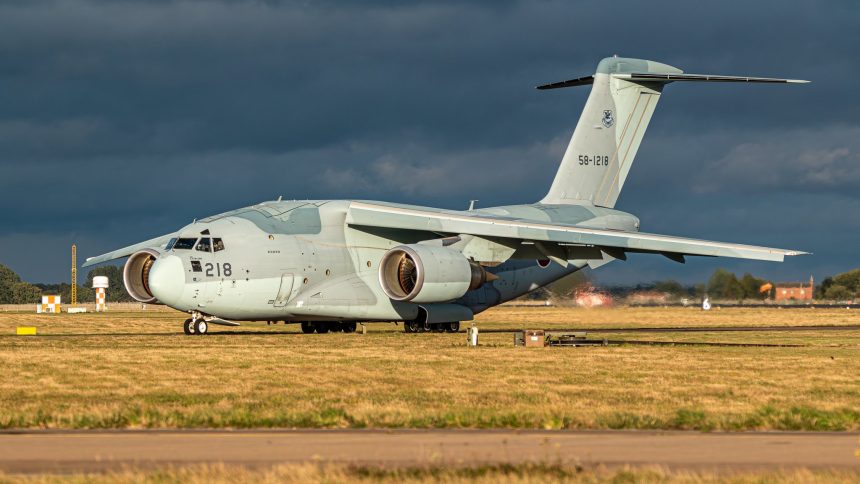In the first UK visit for the type outside of an airshow, Kawasaki C-2 58-1218 arrived at RAF Coningsby in stunning evening light on Sept. 17, 2025.
One of two C-2s acting as a support aircraft for Operation Atlantic Eagles, a goodwill deployment of four Japan Air Self-Defense Force (JASDF) F-15J Eagles to Europe, 58-1218 arrived at 1805 local time (1705 UTC) using the callsign Japanese Air Force 101. It departed from CFB Goose Bay, Canada, where the four F-15Js and other support aircraft stopped over after routing via Eielson AFB, Alaska, from Chitose AB, Japan.
58-1218 was delivered in March of this year, making it one of the newest aircraft in the C-2 fleet as well as one of the newest in the whole JASDF. 22 examples of the type have been ordered, currently comprising the base C-2 transport variant and the RC-2 intelligence variant.
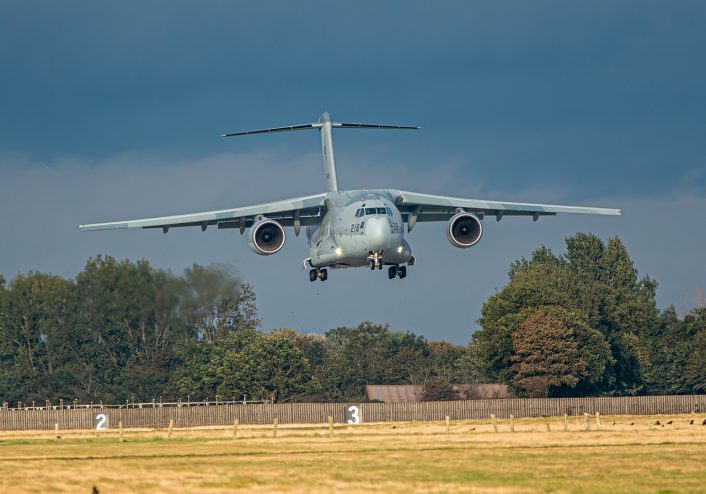
Arriving ahead of the fighter aircraft, the C-2 likely carried personnel and a range of ground equipment to be set up ready to receive the F-15Js when they arrive. Though they would seem to be a fairly universal tool, items like ladders for cockpit and airframe access are often designed uniquely for different aircraft types owing to varying heights and fuselage profiles. Additionally, intake blanks and other protective gear will be required upon arrival. A more wide ranging complement of spares and equipment, as well as additional personnel, would follow on aboard the second C-2 as well as the KC-46 and KC-767 refueling aircraft supporting the fighters’ transit.
Sept. 18, 2025#JASDF Chitose Air Base #Eielson AFB #Goose Bay ==> #RAF Coningsby#JF101 #87CDE4 JASDF Kawasaki C-2 pic.twitter.com/3Fo4i0nVDj
— Heo TaeJin (@AIYeyENGDdJkjTr) September 17, 2025
The Kawasaki C-2 made its debut visit to the UK in 2018 when airframe 68-1203 was exhibited at the Royal International Air Tattoo, RAF Fairford, commonly known as RIAT. 18-1215 then followed in 2022, again for RIAT. This visit, then, marks the first visit for the aircraft type to the UK outside of an airshow. Though they resemble U.S. Air Force aircraft serial numbers, which often begin with the financial year the aircraft was ordered, Japanese serial numbers follow a different pattern.
The first digit refers to the final digit of the year of manufacture – 18-1215 was delivered in 2021, 68-1203 in 2016, and, as mentioned above, 58-1218 in 2025. The second digit is assigned based on aircraft type, though because of the number of aircraft types in service both now and in the past this is not unique. The number 8, used for the Kawasaki C-2, was also used for its C-1 predecessor. The third digit – the first after the hyphen – denotes the aircraft’s base role. All C-2s carry a ‘1’ in this spot, which signifies a transport aircraft, while all the visiting F-15s carry ‘8’, which is one of the numbers used for fighter aircraft. Finally, the last three digits are sequentially assigned, with the first C-2 wearing ‘201’ and each following aircraft counting up from there.
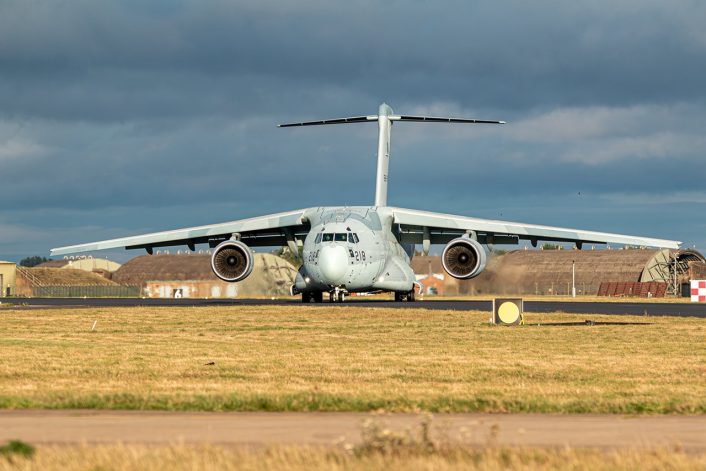
Though the Japanese contingent arrives in the midst of Exercise Cobra Warrior 25-2, it is widely reported that the F-15Js are unlikely to fly during their UK visit. Japanese newspaper Asahi quoted General Hiroaki Uchikura, a former JASDF pilot and current Chief of Staff of the Joint Staff Office, saying: “It is very stressful to fly to a country one has never flown to and to land at an airport never before visited. The preparations that are needed are beyond imagination, but if this is pulled off, it will be very meaningful.”
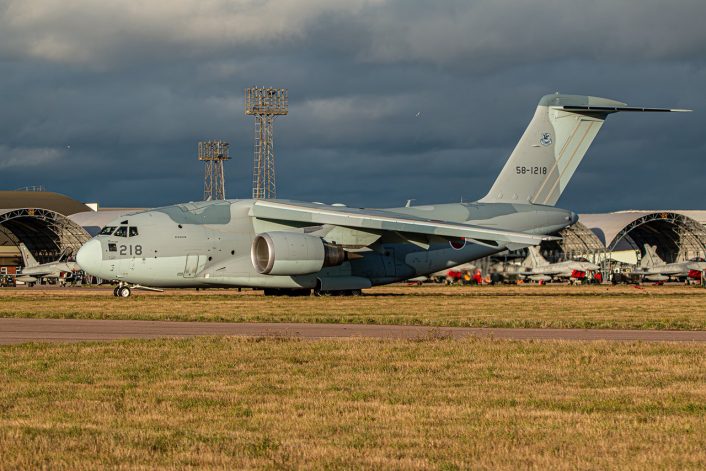
It is hoped, though, that this initial goodwill visit – the first ever deployment of JASDF fighter aircraft to Europe – will pave the way for future deployments with more flight activity. Such deployments would become easier to plan in the future with the entry into service of the Global Combat Air Programme (GCAP) fighter, with JASDF aircraft theoretically able to share existing support equipment and spares from the UK’s fleet.
The rest of the JASDF aircraft are expected to arrive in the UK on Sept. 18, with the F-15Js likely to arrive in at RAF Coningsby in the evening. The two refueling aircraft are due to be stabled alongside the RAF’s transport fleet at RAF Brize Norton. After several days of cultural exchanges with UK crews, the Japanese force will then depart for the next leg of the Atlantic Eagles deployment in Laage, Germany.
Kawasaki C-2
The C-2 was designed by Kawasaki to replace its earlier C-1 transport aircraft. It is, like its predecessor, a homegrown Japanese design, with no foreign developed aircraft assessed as providing all of the capabilities that Japan required in its new airlifter. The first airframe performed the type’s maiden flight in January 2010, and the C-2 formally entered Japanese service six years later in 2016.
Though smaller than four-engined jet transports like the C-17 Globemaster III, the C-2 is significantly larger than the C-1 it replaced and is roughly equivalent in capacity to the Airbus A400M. Compared to the turboprop airlifter, though, the C-2 offers a higher cruise speed, service ceiling, and increased range. Its General Electric CF6 turbofan engines are widely employed in both civilian and military service, powering the Airbus A330, Lockheed C-5M Super Galaxy, and a portion of Boeing 747s including the U.S. Air Force’s VC-25A and E-4B aircraft. It is also used by Japan’s KC-767 tankers, though the newer KC-46s instead use Pratt & Whitney powerplants.
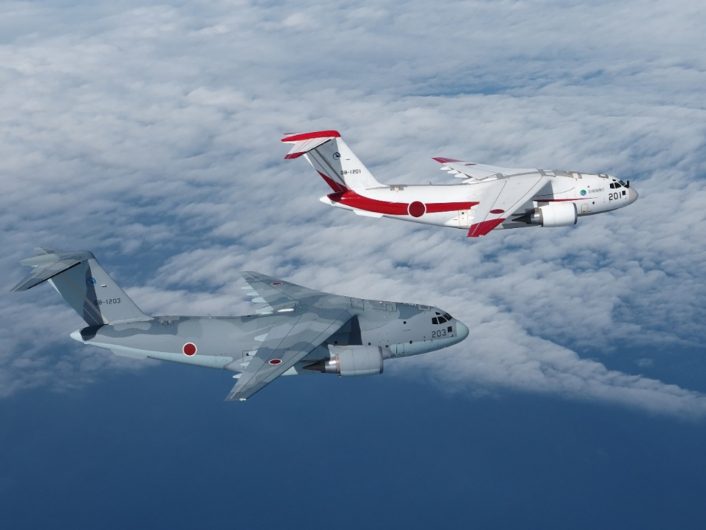
The main drawback to the C-2 stems from its bespoke nature and low order numbers, not able to benefit from the economies of scale that many of its competitors can. This makes it a more unattractive prospect for the export market, but Kawasaki is investigating ways to counter this issue and make production less expensive. Until the mid-2010s, Japanese laws placed heavy restrictions on the export of military equipment.
Since changes in these laws, manufacturers like Kawasaki have been hard at work promoting products like the C-2 and their P-1 maritime patrol aircraft at overseas airshows. Some parties have also reportedly expressed interest in the unique ShinMaywa US-2 seaplane.
In essence, this opening of the Japanese military export market to the world goes hand in hand with the country’s eagerness to increase military cooperation with allies through missions like Atlantic Eagles. Aviation enthusiasts in the West will be eager to see these developments continue, with the only way to see many of Japan’s unique aircraft in the past being to make the expensive trip across to Asia themselves.
Many thanks to Glenn Lockett for allowing us to use these incredible images of the C-2’s arrival!

